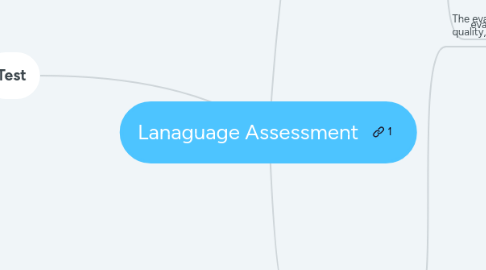
1. Test
1.1. a procedure intended to establish the quality, performance, or reliability of something, especially before it is taken into widespread use.
1.2. Types of Tests
1.2.1. Diagnostic Tests
1.2.1.1. These tests are used o diagnose how much you know and what you know. They can help a teacher know what needs to be reviewed or reinforced in class. They also enable the student to identify areas of weakness.
1.2.2. Placement Tests
1.2.2.1. hese tests are used to place students in the appropriate class or level
1.2.3. Progress or Achievement Tests
1.2.3.1. Achievement or progress tests measure the students improvement in relation to their syllabus.
1.2.4. Proficiency Tests
1.2.4.1. They provide a broad picture of knowledge and ability. In English language learning, examples are the TOEFL and IELTS exams
1.2.4.2. They provide a broad picture of knowledge and ability. In English language learning, examples are the TOEFL and IELTS exams
1.2.5. Internal Tests
1.2.5.1. Internal tests are those given by the institution where the learner is taking the course.
1.2.6. External Tests
1.2.6.1. External tests are those given by an outside body. Examples are the TOEFL, TOEIC, IELTS, SAT, ACT, LSAT, GRE and GMAT.
1.2.7. Objective Tests
1.2.7.1. Objective tests are those that have clear right or wrong answers. Multiple-choice tests fall into this group.
1.2.8. Subjective Tests
1.2.8.1. Subjective tests require the marker or examiner to make a subjective judgment regarding the marks deserved.
1.2.9. Combination Tests
1.2.9.1. Many tests are a combination of objective and subjective styles
2. Evaluation
2.1. It is making of a judgment about the amount, number, or value of something;
2.2. it use creatiria
2.2.1. relevance
2.2.2. eficiency
2.2.3. effectivness
2.2.4. impact
2.2.5. sustainability
2.2.6. impact
2.3. Evalauting humanitary action
2.3.1. CONNECTEDNESS
2.3.2. COHERENCE
2.4. evalautin humanitery action
3. Assessment
3.1. The evaluation or estimation of the nature, quality, or ability of someone or something
3.2. Type
3.2.1. Formative Assessment
3.2.1.1. It is an integral part of teaching and learning
3.2.2. Summative Assessment
3.2.2.1. It demonstrates the extent of a learner's success in meeting the assessment criteria used to gauge the intended learning outcomes of a module or programme
3.2.3. Authentic Assessment
3.2.3.1. It is an assessment where the tasks and conditions are more closely aligned to what you would experience within employment.
3.2.4. Diagnostic Assesment
3.2.4.1. it is intended to improve the learner’s experience and their level of achievement.
3.2.5. Dynamic assessment
3.2.6. Dynamic assessment
3.2.6.1. IT measures what the student achieves when given some teaching in an unfamiliar topic or field
3.2.7. Synoptic assessment
3.2.7.1. it encourages students to combine elements of their learning from different parts of a programme and to show their accumulated knowledge and understanding of a topic or subject area.
3.2.8. Ipsative assessment
3.2.8.1. his is assessment against the student’s own previous standards.
3.2.9. Criterion referenced assessment
3.2.9.1. Reliability and validity should be assured through processes such as moderation, trial marking, and the collation of exemplars.
3.2.10. Summative Assessment

